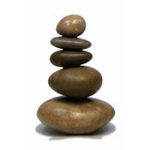How to run a creative workshop based on Large Two Forms
Artwork by Henry Moore, created in 1969
About this activity
Workshop themes
- Buddhism
- Mindfulness
- Relaxation
Suitability
- Suitable for groups
- Suitable for one to one
Difficulty level
Medium

Skip to section
Introductions
Materials
- Name badges (for all participants and staff).
Method
- Go around the room and make eye contact with everyone, shake their hand and say hello.
- Make sure that everybody is sitting comfortably in their chair.
- Explain that the session will begin by focussing on your breath for just one minute. People can close their eyes if they wish, or focus on a point in the room. Maybe provide a plant or some flowers as a focal point. It may be easier to guide people through the exercise by using the script here.
- Start by inviting the group to start by breathing in and out slowly. One breath cycle should last for approximately 6 seconds.
- Encourage people to breathe in through their nose and out through their mouth, letting breath flow effortlessly in and out of their body.
- Tell people to try and let go of their thoughts and to focus on their breathing as it comes into their body and out again.
- Think of each breath flowing out of their body and filling the space around them, and then into the room. When you reach one minute, invite people to look at you again.
- Ask if they enjoyed the exercise. How did they find it?
- If they found it relaxing maybe next time you could try two minutes, or even three?
TimeSlips™
Materials
- Flipchat and pen
- An image of the artwork (can be viewed in the app or printed from this link )
Method
- Look at the artwork using the Armchair Gallery app.
- Welcome and invite the person or group to create with you and write their answers on the flip chart. Ask open-ended questions (like in the list to the right).
- Affirm/echo all their answers - together we build a story that can have sound, movement, words - even drawings.
- Retell the story, then invite them to add another creative element like sound, or movement.
Suggested Questions
- What is going on in the picture?
- What do you think it is?
- What do you think the artist is trying to say here?
- What colours and shapes can you see?
- What do you think it is made of?
- Why do you think the work is positioned here?
- What do you think it would feel like?
- What size do you think it is?
- What would you name this artwork?
Play this video
Workshop members can watch this on their own tablet, or you can play it to the group by connecting your tablet to a TV or projector. It can also be downloaded from the Armchair Gallery website.
Interact with the artwork
At this point in the workshop participants should have a go at using the app to interact with the artwork. From the main menu, enter Yorkshire Sculpture Park, select Large Two Forms and tap Interact and play.
Multi-Sensory Exploration, Part 1
Materials
- iPad or laptop and speakers for music.
- Fruits such as watermelon, kiwi and pineapple.
- Sculptural figurines or natural objects.
- Glass or plastic bottles.
- Coloured sand.
- Kebab sticks.
- Funnels.
- Diffuser, flannel or tissue.
- An assortment of essential oils.
Sound
- Enjoy listening to some relaxing music. Try to listen to something that doesn’t have words but has a steady rhythm. Lots of this music can be found on Spotify and you could create your own relaxation playlist.
- Music can be incorporated into the warm-up and/or celebration.
Multi-Sensory Exploration, Part 2
Taste
- Explore mindful eating by passing around a variety of different fruit textures such as watermelon, kiwi and pineapple. As you pass these around, ask your group to really appreciate the taste, texture and to enjoy them.
Touch
- If you have access to any sculptural figurines (or something similar), pass these around the group and encourage them to touch and explore the shapes of the figures.
- Linking in with the landscape theme, a variety of natural objects could be passed to participants such as smooth or rough stones, tree branches, leaves etc.
Multi-Sensory Exploration, Part 3
Sight
- Find an old glass or plastic bottle. Using an assortment of coloured sand, layer different colours of sand in the bottle using a funnel. This will create a layered effect and is relaxing to do.
- A kebab stick can then be pushed down the side of the bottle to create patterns in the sand.
- If you have space, Rangoli patterns could be created on the floor using a selection of coloured sands and funnels, or even lentils and pulses.
Smell
- Using a diffuser, flannel or tissue, add a couple of drops of your chosen essential oil to create a relaxing scent in the room, see guides here.
Please note that some research may be required when using certain aromatherapy oils. Be careful with any allergies that people may have with the oils, or people that you may gift the bath bombs too. Also note that some essential oils are not good to work with during pregnancy i.e. These include fennel, clary sage, marjoram, tarragon, caraway, cinnamon, thuja, mugwort, birch, wintergreen, basil (estragole CT), camphor, hyssop, aniseed, sage, tansy, wormwood, parsley seed or leaf, and pennyroyal. (please check with a health professional if you are unsure)
Making: Mandala Stone
Making: Mandala Stone
Pebble painting is a growing craze. This activity is inspired by the theme of landscape art and the beautiful outdoor landscape of the Yorkshire Sculpture Park. Each stone is unique and can be designed with as much originality as people wish!
Materials
- Stones.
- Acrylic paints.
- Paint palette.
- Cotton buds.
- Mod Podge.
- Paintbrushes.
- iPad and speakers (for music).
Method
- Choose your stone or pebble. Begin by painting it with a layer of white (or one paint colour) paint so that any decoration will show up.
- Using a cotton bud, add spots of paint on in a symmetrical pattern, starting in the centre. You can change the size of these spots by overlapping them so they become bigger.
- Continue to add more spots, alternating the pattern and colour as the work progresses.
- Leave to dry for approximately 30 minutes
- Add a layer of Mod Podge onto the stone to glaze it. This will make it waterproof and protect it in all weathers.
- The completed Mandala stones can then be displayed in the garden or add some colour by putting them on a windowsill!
Celebration
To finish the session based on mindfulness and relaxation, teach your group some Tai Chi, such as the yin yang
the yin yang
the repulse monkey
the eagle seeks its prey
. Take your time going through these and finish with silence and quiet time. Thank everyone for attending and for taking part and then conclude with a round of applause.
Finally…
Getting Materials
You should be able to get most of the materials mentioned in this guide at your local arts supplier.
They are also avaiable on Amazon. If you shop via Amazon Smile (using the button below - UK only), then we will recieve a donation that we can put towards our work with older people.
Other Apps
You could use these other apps to further explore digital technology in your workshop.


